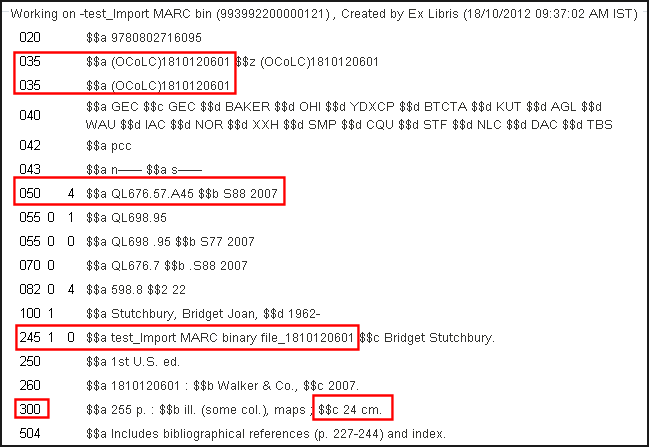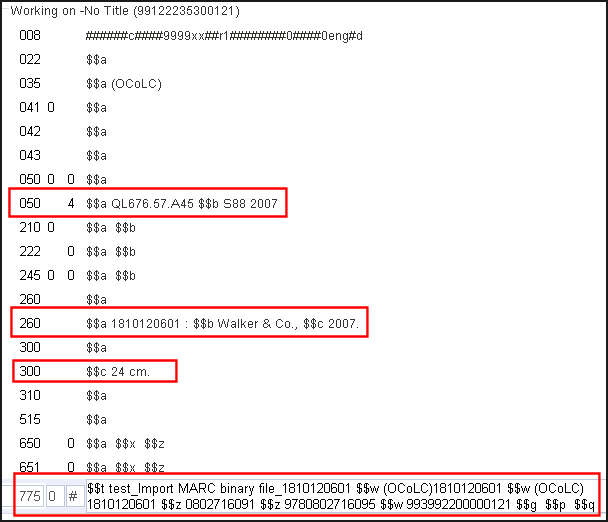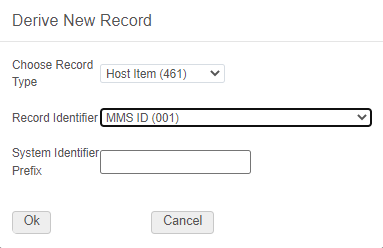Deriving a New Bibliographic Record
The Derive New Record tool in the MD Editor allows you to use the related bibliographic record and the default template as the basis to create a new record. Based on the selection of the relation type (Host Item or Other Edition), the MMS ID of the copied record is placed in the connector field for the relation job to run and enhance the new record.
The connector fields are different between the MARC profile types and are as follows:
- MARC21/KORMARC - Host Item (773) & Other Edition (775)
- UNIMARC - Host Item (461) & Other Edition (451)
Deriving a New Bibliographic Record - MARC 21
The Derive New Record tool for MARC21/KORMARC includes the following types of relations:
- Host Item (773) – An analytical record that refers to a specific article in a journal that is described by another bibliographic record.
- Other Edition (775) – A record that describes other editions of the same bibliographic record.
Each of the above fields includes the following subfields, which are populated from the original related record:
- t – The original 245.a (title).
- w – A repeatable subfield that contains the 035.a subfield for each 035 field or the original MMS ID.
- x – A non-repeatable ISSN (if it exists in 022.a). The tool uses the first occurrence only.
- z – A repeatable ISBN (if it exists in 020.a/020.e).
- g – Related parts. This is a required subfield, but it must be entered manually. The tool includes a placeholder in the field.
- p – Abbreviated title. This is a required subfield, but it must be entered manually. The tool includes a placeholder in the field.
- q – Enumeration of first page. This is a required subfield, but it must be entered manually. The tool includes a placeholder in the field.
The system removes empty subfields when the new holdings record is saved.
In addition, this tool includes the following fields from the original related record and combines them with fields from the default template:
- 050, 080, and 260 - Includes only the first occurrence from the original related record, but also includes other occurrences from the default template.
- 300.c - Includes all occurrences of the 300 field that have a c subfield from the original related record. Note that tool copies only the c subfield from the original related record.
For example, the following figure shows the fields that were used to populate the new derived record:

The following figure shows the results of the new derived record. The non-highlighted fields are taken from the default template:

Alma does not create a related record link if you include the MARC code in parenthesis before the record number in the $w subfield of a 773 or 775 tag. An example of this is in the above figure in the 775 tag: ... $$w (OCoLC)1819120601 ... Therefore, it is recommended to not used parenthesized MARC codes in $w subfields in 773 and 775 tags.
Deriving a New Bibliographic Record - UNIMARC
The Derive New Record tool for UNIMARC includes the following types of relations:
- 461 (Host Item)
- 451 (Other Edition) fields
The related record information in the UNIMARC 4XX fields continues to be maintained in that manner in Alma (similar to the 77X fields in the MARC 21 format).
In addition, this tool takes the following UNIMARC fields from the original related record and combines them with fields from the default template:
- MMS ID (001)
- 035 $a
- 200 $a
- 210 $a $c $d
- 215 $a $c $d $e
Deriving a New Record
- Open the MD Editor (Resources > Cataloging > Open Metadata Editor).
- Specify the default template and open the related record to which you want to link.
- Select Record Actions > Derive New Record.
- In the Choose Record Type field, select:
- MARC21/KORMARC - Select Host Item (773) or Other Edition (775).
- UNIMARC - Select Host Item (461) or Other Edition (451).

- In the Record Identifier field, select from where will the connecting ID is taken:
- MMS ID (001) - This is the default option for UNIMARC profile.
Since Alma uses the 001 field for the record ID (MMS ID), and the previous system ID is maintained in the 035 field, the Alma related records logic checks the 035 field for previous system IDs contained in the UNIMARC 4XX fields. The links between these records are created with the Alma MMS - Build Record Relations job (see Viewing All Scheduled Jobs) that is scheduled to run every day. Throughout the ongoing movement of records via import, export, publishing, copy cataloging, and editing with the MD Editor, Alma continues to maintain and manage bibliographic records using this format, logic, and processing. - Other System Number (035)
When you select this option and specify the System Identifier Prefix (e.g., SBN), the ID from the 035 field with the specific prefix is placed in the connecting field. - MMS ID (001) and Other System Number (035) - This is the default option for MARC21/KORMARC profiles.
- MMS ID (001) - This is the default option for UNIMARC profile.
- In the System Identifier Prefix field, specify the prefix of the desired system identifier. The prefix is optional. When it is not set, all 035 fields are used
- Select OK to close the dialog and derive the new record.
- For a new MARC21/KORMARC record, enter any additional fields and update the empty g, p, and q subfields in the 773 or 775 field.
- Save your changes to the new record.

